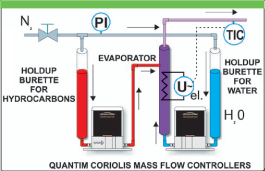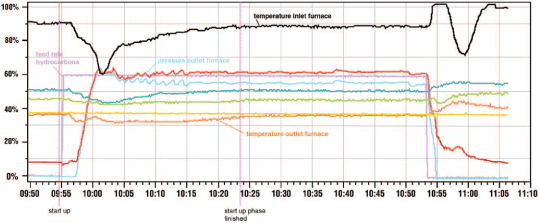|
Feed Rate Control In Hydrocracking Pilot Plants |
A laboratory steam cracker is used to investigate the products obtained by steam cracking of different feedstocks. Especially if feedstocks that have never been cracked before are to be evaluated, an experimental investigation in a lab furnace that accurately covers the process operation conditions of the large scale furnaces is needed. Thus, the lab furnace is an important tool to improve the understanding of the steam cracking process and is a basis to optimize and control production plants.
Some laboratory scale furnaces use a peristaltic dosing pump for water feed and a pressurized burette for hydrocarbon feed, with the pressure difference between the furnace outlet pressure and the pressure of the burette providing the driving force for hydrocarbon flow. Clearly, there are issues with this experimental set-up, including:
- The time needed to start the plant relies strongly on operator skill.
- Certain feedstocks cause strong oscillations of the pressure at the outlet of the furnace due to significant formation of condensates, making the hydrocarbon feed rate difficult to stabilize. It is also very difficult to reproduce exactly the same feed rates in two independent experiments.
THE BROOKS SOLUTION
To overcome those drawbacks, two Brooks QUANTIM Model QMBC mass flow controllers are added to the process to automate feed control. These devices incorporate a Coriolis measurement sensor and precision control valve that deliver 1% or better mass addition accuracy from 2 grams per hour to 7.5 kg per hour. QUANTIM offers the following advantages in this application:

- Reduction in plant start-up time.
- Improved feed rate and accuracy.
- Decrease in the number of experiments required.
- Automatic feed rate control.
DEMONSTRATED RESULTS
Before QUANTIM, start-up of the experiment with a new feedstock took approximately 1.5 hours because flow rates had to be adjusted by hand using the burette pressure as the manipulated variable. After every change of flow rate, the operator had to wait until stable temperature and pressure conditions were reached, then re-check flow and adjust as needed.
Due to QUANTIM’s high reproducibility and precision flow control, start-up time is reduced to just 30 minutes. This is the time needed to reach the desired furnace inlet temperature and is no longer dependent upon the type of feedstock being used.

Within one minute of the "start experiment" command, the hydrocarbon feed controlled by QUANTIM (shown above) is at set-point and steady as a rock.
|


